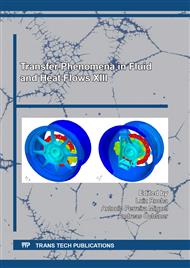[1]
Cheong H. W., Kim J. M., Cho S. B., Kang S. H., Ji H. J., Chung K. I. et al. (2006). Review of thermal battery technologies and R&D activities in Korea. Metals and Materials International, 19(5), 14-21.
Google Scholar
[2]
Ji H. J. A study on the basic model for simulating performance of thermal-batteries. (2008). Journal of the Korea Institute of Military Science and Technology, 11(1), 102-111.
Google Scholar
[3]
Lee. J., Ha. S. H., Kim. K. Y., Cheong. H. W. & Cho. S. B. (2016). Enhancement of thermal insulation performance with phase change material for thermal batteries. Journal of the KIMST, 19(4), 469-475. DOI:http://dx.doi.org/10.9766/KIMST.2016.19.4.469.
DOI: 10.9766/kimst.2016.19.4.469
Google Scholar
[4]
Kim J. Y., Lee J. I & Ha S. H. (2015). A study on temperature distribution of thermal battery by numerical simulation. Korea Energy Society, 2015(11), 111-111.
Google Scholar
[5]
Cho G. H., Riu D. H., Hu S. H., Shin D. G., Kim H. E., Choi J. H et al. (2008) Wetting behavior of molten salt on the ceramic filter separators for thermal batteries. Journal of the Korean Ceramic Society, 45(7), 423-429.
DOI: 10.4191/kcers.2008.45.7.423
Google Scholar
[6]
Jeon H. S., Choi H. J., Choi G. S., Kang J. S., Lee S. E. (2009). thermal property characteristics of super insulation vacuum panel. The Society of Air-Conditioning and Refrigerating Engineers of Korea, 2009(6) 599-602.
Google Scholar
[7]
Yoo C. J., Kim M. C., Go S. S. (2019). A study on the thermal insulation performance of vacuum insulation panel using dry processing glass fiber core. Journal of the Architectural Institute of Korea Structure & Construction 35(6), 121-128.
Google Scholar
[8]
Jung H. Y., Bae M. J., Choi G. S. & Kim Y. T. (2020). Study on effective thermal conductivity of vacuum insulation panels manufactured by different envelope materials. Journal of Korean Institute of Architectural Sustainable Environment and Building Systems 14(6), 2020.12, 719-730.
Google Scholar
[9]
Jin C., Song K., Liu J., Ge B., Zhao L., Pu X. & Li W. (2020). Flexible, self-assembly NiS2/C thin film cathodes for long life thermal battery. Journal of Alloys and Compounds 833. DOI:https://doi.org/10.1016/j.jallcom.2020.155091.
DOI: 10.1016/j.jallcom.2020.155091
Google Scholar
[10]
Lee. J., Ha. S. H., Kim. K. Y., Cheong. H. W. & Cho. S. B. (2016). Enhancement of thermal insulation performance with phase change material for thermal batteries. Journal of the KIMST, 19(4), 469-475.
DOI: 10.9766/kimst.2016.19.4.469
Google Scholar
[11]
Yazdani A., Sanghadas M. & Botte G. G. (2020). Ionic conductivity and thermal stability of lithium salt/potassium bifluoride electrolytes for thermal batteries. Journal of Power Sources 453. DOI:https://doi.org/10.1016/j.jpowsour.2020.227854.
DOI: 10.1016/j.jpowsour.2020.227854
Google Scholar
[12]
Freitas, G. C., Peixoto, F. C. & Vianna, A. S. (2006, September). Modeling and simulation of the heat transfer in a thermal battery. In ECCOMAS CFD 2006: Proceedings of the European Conference on Computational Fluid Dynamics, The Netherlands, September 5-8, 2006. Delft University of Technology; European Community on Computational Methods in Applied Sciences (ECCOMAS).
Google Scholar
[13]
Lee J. H., Song T. H. (2019). Study on radiation shields in the core of vacuum insulation panels. International Journal of Heat and Mass Transfer 129, 380-388.
Google Scholar
[14]
Matweb, LLC. (1996). Matweb Material Property Data. Retrieved from http://www.matweb.com/services/services.aspx.
Google Scholar
[15]
CD-Adapco. (2017). Star-CCM+ver. 12.04 User Guide.
Google Scholar
[16]
The Engineering ToolBox. (2001). Engineering ToolBOX. Retrieved from https://www.Engineeringtoolbox.com/.
Google Scholar
[17]
Kim J. H. & Kim. J. T. (2017). The study of long-term performance evaluation of vacuum insulation panel(VIP) with accelerated aging test. Journal of the Korean Solar Energy Society 37(4), 35-47. DOI: https://doi.org/10.7836/kses.2017.37.4.035.
DOI: 10.7836/kses.2017.37.4.035
Google Scholar


